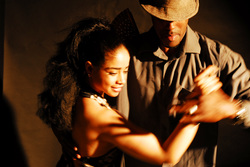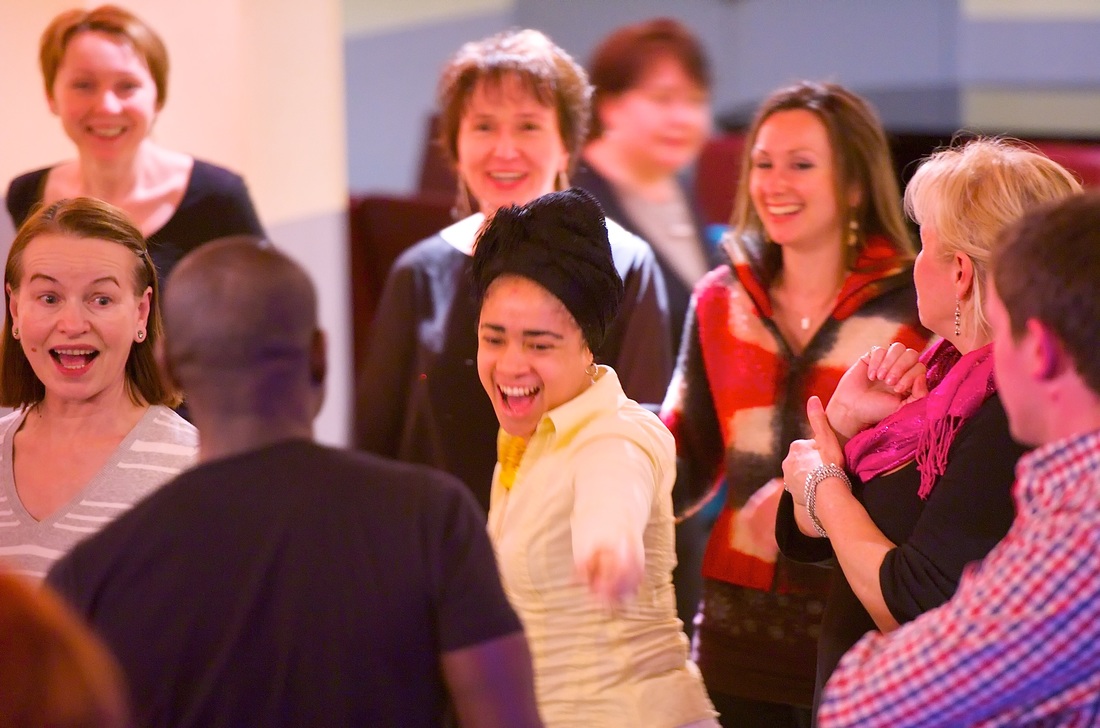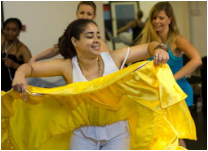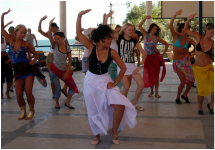DUE TO CORONA-VIRUS all Courses are due to start in APRIL
REGGAETON - Get it Right! -5 weeks course by DCubanSchool
Time & LocationDate and Time
Thu, April 2020, 20:00 Location The Place Dance Studios , Flaxman Terrace, Kings Cross, London WC1H 9AT Refund Policy: No Refunds
No Exchangable Share With Friends |
Learn to dance or improve your Cuban Reggaeton and Body movement techniqueDancing is one of the best ways to relieve stress and bring happiness to your life. We offer Reggaeton classes that are full of fun along with great technique.
What is GET it RIGHT !GET it Right! - are progressive course syllabus created by Damarys F-T of DCubanSchool and delivered by DCubanSchool teachers team, under her supervision.
What you will learn
Why dance with us?Get it right from the beginning!
We focus on posture, technique, enjoyment and no, we Don't Believe In Two Left Feet! Our classes are designed to help you work on posture, technique, connection and musicality, while learning authentic, exciting moves, to make your dance more versatile, fluid and enjoyable.... Classes are held in comfortable dance studio. We promote excellent teaching and enjoyment as at part of the course we encourage our students to join us for social dancing, performances and more. So join us |
No dance partner neededCome on your own or join us with a group of friends.
|
All dance levels welcome |
Flexible payment optionsWhether you want to join us for a single class or pay for a few weeks with a discount.
|
Start your Reggaeton experience with one of these classes option below
Direct Transfer infoCourse duration: ONLY 5 weeks !
|
ONLINE PAYMENT OPTION |
|
We operate a ticket-free scheme. Your name will be registered on our list at the door. If you prefer to the a transfer please email us with your name and class name or fill up the booking form at the end of the class you selected page. Please make £75 transfer to: Name: Cuban School of Arts Branch: HSBC Sort code: 40-02-17 Account: # 21570412 DON’T MISS OUT! Sign up now! Reference: REGG plus your name & date *Payment are not refundable neither transferable. **There are limited spaces available on this course. ***Drop in needs to be transfer minimum of 2 days in advance |
|
Testimonials
Wao!! This is a challenging and uplifting course. The best Reggaeton course in London by far. All movements are breakdown into detail. Definitely will recommend it. I love you Damarys! Your classes are absolutely amazing. Beautifully thought, structured and grate pace. You break down the steps and body isolation very well. I love it. Reggaeton course with beautiful Damarys Farres! What an inspiring woman! Your good vibes and happiness are contagious.. |
|
What is reggaeton?
Reggaeton popular dance music of Puerto Rican origin, characterized by a fusion of Latin rhythms, dancehall, and hip hop or rap.
However we teach Cuban Reggaeton which has its own specific beat and rhythm.
However we teach Cuban Reggaeton which has its own specific beat and rhythm.
What is body isolation technique?
Body Movement & Isolations
Steps and patterns will only get you so far. Body movement and isolation exercises will be your ticket to making things look smooth.
Lack of body movement normaly leaves the dancer look disconnected somehow, missing a certain flow. Also the ability of the different body parts to move in all kind of ways adds to your movement reportoire and makes you able to interpret the music better.. Some movements also require a certain flexibility, that will have to be trained. Especially the spine can be stiff if not used, and it may take a while to rebuild that flexibility.
Doing basic isolation exercises should be a regular practice. You should be able to move your hips, torso and shoulders in different directions, first concentrating on one move at a time, later you can do several moves simultaneously.
Developing good dance body movement will take time, a lot more than you might think. The flexibility and coordination necessary is a lot higher than learning to make your feet do side- and backsteps. Create a practice plan and do the basic isolation exercises as often as possible. It doesn't need to take more than a couple of minutes each time, but you will need continuos repetition to achieve results
Isolations will strengthen your coordination. Although we're working to cleanly seperate the different movements at first, the aim is to put it all back together in the end to create smooth flowing yet higly complex moves.
Basic Isolation Exercises
Directions Of Body Movement: We can move our body and its parts in different directions, like up-down, left-right, front-back, and in many more two- and three-dimansional ways like diagonally. These directional movements can be created with our hips, torso and shoulders (and every other body part for that matter, but for Cuban Popular such as Salsa & Cuban Reggaeton dancing these are the most used parts).
Hip Isolations: The hips already move with the cuban motion, but we can also add some more styling to them, like hip-swings, pops and circles. Practice swinging your hips from left to right and tilting your pelvis front and back. Connect those four points and make the hips circle in both directions.
Isolation Exercises For The Torso: The torso, or ribcage, plays a very active part in creating all kinds of moves and styling. Since it's the spine that is moving, the range of motion is very high in all directions. What we use normally is the side-to-side motion partially created by the cuban motion, or the front to back motion creating for example body waves. Stretch out your arms to the sides, and pull your ribcage to your right and left. Keep your shoulders level (avoid tilting your arms up and down like a child "playing airplane"). Take your arms down and move your solar plexus (the point under your sternum) front and back. Note that it is NOT your shoulders that are moving, they should follow the movement of your torso, but not initiate it. Then connect again the four directions creating circles, also here your shoulders should be level, so your upper body is not collapsing to either side.
When you're isolating the ribcage your hips should not be moving (and vice versa). You need to ground yourself and keep your body weight between both legs, avoiding any sway.
Shoulder Isolations: The shoulders are an easy part to move, and many beginners move them excessively to compansate a lacking cuban motion. The shoulders most often are rolled or shaken (shimmies).Practise rolling the shoulders backward and forward, first individually, then alternating. When rolling both shoulders imagine they are connected with a stick, so that when one shoulder goes up, the other goes down and vice versa. For the shimmies practice moving your shoulders front and back in a straight line. The movement comes from your back muscles, so don't try to "push your shoulders forward" but rather "pull them backwards". Try to breathe evenly as you build up tempo.
Steps and patterns will only get you so far. Body movement and isolation exercises will be your ticket to making things look smooth.
Lack of body movement normaly leaves the dancer look disconnected somehow, missing a certain flow. Also the ability of the different body parts to move in all kind of ways adds to your movement reportoire and makes you able to interpret the music better.. Some movements also require a certain flexibility, that will have to be trained. Especially the spine can be stiff if not used, and it may take a while to rebuild that flexibility.
Doing basic isolation exercises should be a regular practice. You should be able to move your hips, torso and shoulders in different directions, first concentrating on one move at a time, later you can do several moves simultaneously.
Developing good dance body movement will take time, a lot more than you might think. The flexibility and coordination necessary is a lot higher than learning to make your feet do side- and backsteps. Create a practice plan and do the basic isolation exercises as often as possible. It doesn't need to take more than a couple of minutes each time, but you will need continuos repetition to achieve results
Isolations will strengthen your coordination. Although we're working to cleanly seperate the different movements at first, the aim is to put it all back together in the end to create smooth flowing yet higly complex moves.
Basic Isolation Exercises
Directions Of Body Movement: We can move our body and its parts in different directions, like up-down, left-right, front-back, and in many more two- and three-dimansional ways like diagonally. These directional movements can be created with our hips, torso and shoulders (and every other body part for that matter, but for Cuban Popular such as Salsa & Cuban Reggaeton dancing these are the most used parts).
Hip Isolations: The hips already move with the cuban motion, but we can also add some more styling to them, like hip-swings, pops and circles. Practice swinging your hips from left to right and tilting your pelvis front and back. Connect those four points and make the hips circle in both directions.
Isolation Exercises For The Torso: The torso, or ribcage, plays a very active part in creating all kinds of moves and styling. Since it's the spine that is moving, the range of motion is very high in all directions. What we use normally is the side-to-side motion partially created by the cuban motion, or the front to back motion creating for example body waves. Stretch out your arms to the sides, and pull your ribcage to your right and left. Keep your shoulders level (avoid tilting your arms up and down like a child "playing airplane"). Take your arms down and move your solar plexus (the point under your sternum) front and back. Note that it is NOT your shoulders that are moving, they should follow the movement of your torso, but not initiate it. Then connect again the four directions creating circles, also here your shoulders should be level, so your upper body is not collapsing to either side.
When you're isolating the ribcage your hips should not be moving (and vice versa). You need to ground yourself and keep your body weight between both legs, avoiding any sway.
Shoulder Isolations: The shoulders are an easy part to move, and many beginners move them excessively to compansate a lacking cuban motion. The shoulders most often are rolled or shaken (shimmies).Practise rolling the shoulders backward and forward, first individually, then alternating. When rolling both shoulders imagine they are connected with a stick, so that when one shoulder goes up, the other goes down and vice versa. For the shimmies practice moving your shoulders front and back in a straight line. The movement comes from your back muscles, so don't try to "push your shoulders forward" but rather "pull them backwards". Try to breathe evenly as you build up tempo.
CUban - reggaeton music




